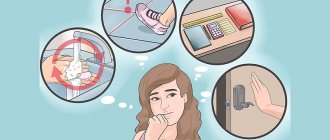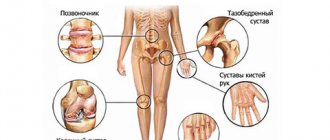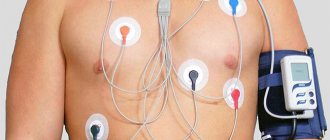Agoraphobia is a neurotic mental disorder, manifested by a fear of open space, squares and streets, where a large number of people with unpredictable demands and reactions could potentially appear or are already present. This phobia is a protective mechanism of the psyche in response to previously received psychological trauma associated with people. Belongs to the group of obsessive-compulsive neurotic disorders, that is, neuroses characterized by obsessive fear and the possible formation of “protective” obsessive rituals (actions). The intensity of agoraphobia can vary, but in any case it involves avoidance of the source of the perceived fear. Depending on the intensity of its manifestations, a phobic disorder based on the fear of open space and crowds is the most maladaptive among all other types of phobias.
Symptoms of agoraphobia
Agoraphobia is often accompanied by other obsessive fears: fear of closed spaces, fear of getting sick, fear of losing control of oneself, fear of death, etc.
Obsessive fear may be accompanied by autonomic reactions: sensations of heartbeat and lack of air, “waves” of heat or cold throughout the body, trembling (or a feeling of internal trembling), “lump in the throat” and “heaviness in the chest.” Agoraphobia can also be accompanied by depression and panic attacks.
Most people who experience such fear understand its “absurdity” and agree that, most likely, nothing terrible will happen when leaving the house. But they can’t do anything by themselves, since anxious doubts seize them every time even at the thought of going out into the street.
Causes of agoraphobia: predisposition (about 20% of the population is predisposed to anxiety disorders), depression and neuroses, consequences of traumatic situations, etc.
Etiology
There are several theories explaining the pathogenetic mechanisms of the development of agoraphobia:
- Psychoanalytic. It is assumed that the disorder may be associated with some traumatic event (physical or sexual violence, conflict with friends and/or relatives, job loss, serious illness or death of a loved one, etc.).
- Cognitive. According to this hypothesis, the main cause of agoraphobia is the psychological characteristics of the person himself. The syndrome often develops in suspicious people, hypochondriacs, who are frightened by even minor somatic symptoms (for example, a rapid heartbeat is interpreted as a sign of a heart attack). But some experts are convinced that such fears are not the cause, but a consequence of agoraphobia.
- Biological. The most likely mechanism for the development of the disease is considered to be congenital or acquired pathological changes in the areas of the brain “responsible” for the formation of feelings of anxiety and fear. At the same time, the balance of catecholamines is disrupted (in particular, the production of norepinephrine), and the concentration of γ-aminobutyric acid, which regulates inhibition and excitation of the central nervous system, decreases. And even minor stress causes a severe panic attack.
- Behavioral. Supporters of this theory do not exclude that agoraphobia is a consequence of some external causes, events that occurred in early childhood. Usually, this is a strong fear due to sudden noise, unexpected departure of parents, unpleasant situations that occurred while the father or mother was not around (for example, a conflict with peers, educators, teachers), etc.
What are the most effective treatments for agoraphobia?
The most effective methods of helping with fear of open spaces include psychotherapy: sessions with a psychotherapist (or psychologist), during which anxious experiences are de-actualized.
In addition, there are effective medications that quickly relieve the symptoms of agoraphobia:
- antidepressants;
- neuroleptics;
- tranquilizers (for a short time);
- mood stabilizers.
Physiotherapy, diet therapy, and exercise therapy are also used. The biofeedback therapy technique, which combines elements of psychotherapy and modern computer technology, has proven itself well.
Most cases of agoraphobia can be treated at home. In severe cases, short-term hospitalization in a hospital may be required.
Diagnostics
Photo: pediatrinfo.ru
If there are signs of agoraphobia, you should consult a psychiatrist who will conduct a clinical examination and confirm or deny the presence of the disease. Diagnosis is carried out by conversation, observation and history taking. Agoraphobia is defined if all the criteria recommended by ICD-10 are present:
- vegetative and psychological symptoms of phobia are the primary expression of anxiety, and not the secondary manifestation of delusions and obsessive thoughts;
- anxiety is a consequence of at least two of the proposed situations: the presence of a crowd of people, being in a public place, moving outside the home, traveling alone;
- a pronounced symptom is avoidance of situations that cause fear and discomfort.
Sometimes psychiatrists additionally use the criteria proposed by DSM-5 (fifth edition of the Diagnostic and Statistical Manual of Mental Disorders). According to this document, with agoraphobia, fear or anxiety in relation to 2 or more of the following situations must be observed for 6 months or longer:
- being on public transport;
- being in open space (squares, parking lots);
- being in a closed space (shop, cinema hall);
- staying in line;
- moving alone outside the home.
Most patients complain of anxious thoughts about deteriorating health or about a hopeless situation in which no one will help them. They are afraid of attacks of fear and panic, avoid frightening situations, and need to be accompanied by friends or relatives. Their anxiety is not proportional to the actual threat, and avoidance behavior leads to significant discomfort and disruption of socialization.
Advantages of treating agoraphobia in our clinic
- We work around the clock.
- Experienced psychotherapists, neurologists, psychiatrists and psychologists with many years of experience and scientific degrees.
- We see you at the clinic or go to your home (which is very important when you first contact someone if you are afraid to leave the house).
- Effective, fast-acting and safe methods of helping with agoraphobia.
- Confidentially.
- If necessary, a certificate of incapacity for work (sick leave) is issued for the period of treatment.
If you are overcome by agoraphobia or any other fears, call us, we will help.
Causes of agoraphobia and risk factors
At the moment, there is no single competent point of view regarding the causes of agoraphobia. Genetic components and factors of early maturation are identified. However, people who suffer from panic attacks (a condition where a person suddenly experiences bursts of fear that last several minutes, in the absence of real danger) are more predisposed to agoraphobia. However, whether these disorders occur in parallel or whether there is a cause-and-effect relationship between them has not yet been identified.
Women are two to three times more likely to have this disorder than men, and it is more common in adolescents and young adults.
Some other factors increase the risk of developing agoraphobia:
- Panic disorder, especially if left untreated.
- Other phobias (including social phobia).
- Having a family history of agoraphobia.
- Having experienced severe stress or other traumatic events.
Sources
- Melnikova M.V. Agoraphobia // Innovative science. 202 No. 6.
- Statsenko Oleg Aleksandrovich, Drozdovsky Yuri Vikentievich, Kralya Oleg Viktorovich Sulpiride in the complex therapy of agoraphobia with panic disorder // Russian Psychiatric Journal. 2011. No.
- Moor L.V., Rakhmazova L.D. Clinical and psychopathological features of agoraphobia with panic disorder in patients of the department of non-psychotic mental disorders // Omsk Psychiatric Journal. 2021. No. 1 (7).
- Pavlichenko A.V. Stages of development of panic disorder and differentiated therapy // BMIK. 2015. No. 2.
- Shukil L.V., Statsenko O.A., Kuznetsova I.G. The influence of stress on the formation and dynamics of the symptom complex of agoraphobia with panic disorder // Omsk Psychiatric Journal. 201 No. 1 (3).
- Burno A.M., Nekrasova S.V., Zuikova N.L. Experience in using the technique of inversion of possibilities for psychotherapy of agoraphobia in the structure of panic disorder // Archives of Internal Medicine. 201 No. S1.
Severity of panic disorder
Depending on the severity of the clinical picture, three degrees of severity of panic disorder are distinguished:
- Mild panic disorder. Up to 4 attacks per month with mild symptoms, moderate anticipatory anxiety, moderate agoraphobia;
- Moderate panic disorder. From 4 to 10 attacks per month with moderate symptoms, obvious anticipatory anxiety, obvious agoraphobia impairing social adaptation, moderate depressive disorder or comorbid mild depressive episode;
- Severe panic disorder. High frequency of attacks (more than 10 per month) with severe symptoms, severe agoraphobia leading to social maladjustment (loss of work), comorbid conditions with severe depressive disorder, alcohol and/or drug abuse, social phobia, generalized anxiety, personality disorders.
Causes
In some patients, the onset of the disease is preceded by severe anxiety. For example, a person was in a store where there was a fire, and the doors were narrow. According to psychoanalytic theories, the patient can benefit from adapting (meeting) the symptoms of agoraphobia. The following causes of pathology are distinguished according to the type of blockage:
- Physical. Most people with a fear of crowds and open spaces suffer from hypoglycemia (low blood glucose levels).
- Emotional. Blocks of this nature are determined by persistent anxiety, strong fears, and premonitions of disasters. There are patients with agoraphobia who were highly dependent on their mother and consider themselves responsible for her happiness. Moreover, often after correction of the relationship with the mother, the disease goes away.
- Mental. Includes fear of madness and death. In childhood, an agoraphobe may have encountered the death or insanity of a loved one. After growing up, he associates even change with death, which leads to panic. In his unconscious lie fears of marriage, moving, adulthood, having a child, changing jobs. At the extreme mental and emotional level, these fears come to the surface.
Connection with the vestibular apparatus
The relationship between agoraphobia and dysfunction of the vestibular apparatus, which is responsible for coordinating movements in space, has been proven. Healthy people easily maintain balance through connections between signals from the visual and proprioceptive systems and the vestibular system.
With an anxiety disorder, its functioning is disrupted, as a result of which patients rely only on tactile and visual signals. When visual cues are unclear, people may become disoriented, for example in crowds or large spaces. Patients may also feel unsure when walking on uneven or inclined surfaces.
Having an anxiety disorder
Agoraphobia can be caused by a pre-existing anxiety disorder. This reason is found in approximately every second case of diagnosed agoraphobia. For this reason, the International Classification of Diseases has assigned separate indices to pure panic disorder and panic disorder with agoraphobia. It is also possible to combine this phobia with other fears. This can be social phobia (associated with public actions), logophobia (fear of speaking), aquaphobia (associated with water), acrophobia (fear of heights).
Prospects
Most patients can improve with medication or behavioral therapy. However, without prompt and effective help, the disorder may become more difficult to treat.
Related posts:
- Can dementia be cured at home? Dementia is acquired dementia, a persistent decline in cognitive activity with loss...
- Features of the course of schizophrenia in men and women Schizophrenia is a disease belonging to the group of endogenous psychoses, since its causes...
- Features of the course of schizophrenia in older people Schizophrenia is a mysterious, terrible disease. In the minds of the general public...
- Psychosis: acute, manic, paranoid Psychosis is a complex mental disorder that may have an underlying…
Think about what situations scare you?
Write and rank them in order of importance. Then begin to imagine how you face your fears, first in your imagination and then in the real world, moving from simple tasks to more complex ones. Write down your emotions and thoughts, speak them out loud, look for new behavior strategies. Once you have experience overcoming anxiety, the symptoms will begin to subside. It is also worth mastering relaxation and self-regulation techniques, working with breathing, and changing your lifestyle. Lack of sleep and stress are strictly contraindicated for agoraphobes; they need to meditate more often, eat well, and develop stress tolerance skills. Any fear can be overcome if you really want it.
Interesting?
Share!








